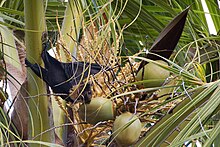Pacific Flying Fox
| Insular flying fox | |
|---|---|
 |
|
| Scientific classification | |
| Kingdom: | Animalia |
| Phylum: | Chordata |
| Class: | Mammalia |
| Order: | Chiroptera |
| Family: | Pteropodidae |
| Genus: | Pteropus |
| Species: | P. tonganus |
| Binomial name | |
|
Pteropus tonganus Quoy & Gaimard, 1830 |
|
 |
|
| Insular flying fox range | |
The insular flying fox or Pacific flying fox (Pteropus tonganus) is a species of flying fox in the family Pteropodidae. It is geographically widespread, the most widespread flying fox in the Pacific: it is found in American Samoa, the Cook Islands, Fiji, New Caledonia, Niue, Papua New Guinea, Samoa (where it is called pe'a fanua, pe'a fai and taulaga), the Solomon Islands, Tonga, and Vanuatu.
Archaeologists on an excavation site at Rurutu announced in 2006 some important fossil finds:
Five bones, representing one adult of the Pacific Flying Fox, Pteropus tonganus, were recovered from an archaeological site on Rurutu (151[degrees] 210 W, 22[degrees] 270'S), Austral Islands, French Polynesia, making this the most eastern extension of the species. For the first time, flying fox bones from cultural deposits were directly dated by accelerator mass spectrometry, yielding an age of death between A.D. 1064 and 1155. Their stratigraphic position in an Archaic period archaeological site and the absence of bones in the late prehistoric to historic layers point to extirpation of the species. No flying fox bones were found in prehuman deposits and human transport of the species cannot be ruled out.
The range of coloration in this bat species varies somewhat. Its back is described as black or seal brown; its mantle has been called orange, yellow, cream buff, and tawny. This bat lacks an interfemoral membrane; its forearms and tibia are bare, and the fur of the males is described as "stiff, short, oily hairs".
...
Wikipedia

